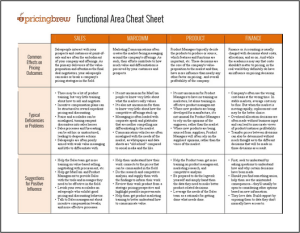In any commercial operation, there are many things that can catch you by surprise if you aren’t prepared. As they impact the entire business, the primary “blindside” concerns tend to be around the usual suspects—sector downturns, natural disasters, terrorist attacks, financial system failures, trade embargos, and so on.
In preparing for these types of events and disruptions, we always say that while you may not know exactly when they are going to happen, you know they’ve happened before and they are almost certain to happen again at some point. And just knowing that, you can leverage past experiences to formulate more thoughtful and effective action plans in advance of those future occurrences; allowing you to respond more quickly, with less frantic scrambling and trial-and-error in the moment.
But beyond the usual suspects, Pricing teams should also be prepared to deal with some curveballs that are less external in nature. While not impacting the entire business, these internal curveballs can nevertheless cast the Pricing function in a negative light and, in some cases, even derail careers…
Changes in Management Priorities
Management priorities can change overnight. Maybe the management team just experienced a particularly contentious board meeting or investor call. Maybe they got wind of a disruptive innovation a major competitor is about to unleash. Or maybe some key members of the management team have just been replaced.
Whatever the reasons, these shifts in management priorities can mean abrupt changes in targets, the focus of projects, or the allocation of resources. This can be particularly challenging….and frustrating…when projects that are already well underway are suddenly deemed less critical or even obsolete. To navigate this curveball effectively, Pricing professionals should:
- Stay aligned with core business objectives: Regular communication with leadership and staying informed about strategic discussions at the top level can provide early warnings of possible changes.
- Build flexibility into planning: Develop strategies and projects with adaptability in mind, so they can be scaled up or down as needed.
- Cultivate strong relationships across the organization: These relationships can offer insights into shifts in leadership thinking and provide advocacy in strategic discussions.
Shifts in Internal Power Structures
Another internal curveball comes when there is a shift in the power structure inside an organization. This could be due to an overall reorganization, a merger or acquisition, or even just natural shifts as departments evolve or as new talent is developed or brought into the company.
Internal power shifts can affect whose voices are most influential, which departments get priority in resource allocation, and how projects are greenlit and funded. Pricing teams must be adept at navigating these changes to maintain influence and ensure their initiatives receive the necessary support. To mitigate the risks of this curveball, Pricing professionals should:
- Engage with new key players: Building relationships with emerging leaders and influencers can help maintain the visibility and relevance of the Pricing team.
- Demonstrate value consistently: Regularly communicate the contributions and successes of the Pricing function to new and existing stakeholders to reinforce the value of ongoing and upcoming projects.
- Stay versatile and proactive: Being able to quickly adapt to new directions or requirements from different parts of the organization is crucial.
Hidden or Assumed Objectives
Hidden or assumed objectives are additional goals or expectations that emerge after the fact or in hindsight, often as addendums to what were thought to be the only objectives all along. For example, a particular strategic initiative might meet all of its stated goals, but then be judged after the fact on some additional criteria that were never clearly communicated earlier on in the process. To avoid getting hit by this curveball, Pricing professionals should:
- Clarify objectives upfront: During the planning phase of any project or initiative, it is vital to ask exhaustive questions to unearth any implicit or assumed expectations. Regular check-ins to reaffirm these goals can also prevent misalignment.
- Foster a culture of transparency: Encouraging open communication and clarity in all projects can help surface these hidden objectives early in the process.
- Document and confirm agreements: Keeping a written record of goals, expectations, and discussions can serve as a reference point to avoid discrepancies later on.
The bottom line is that while preparing for external events and disruptions is of primary importance due to the magnitude and scope of the impacts, Pricing teams can’t afford to ignore the internal dynamics that could negatively affect their standing in the organization and their ability to contribute at the highest levels possible. And by acknowledging and anticipating internal curveballs like changes in management priorities, shifts in power structures, hidden or assumed objectives, and so on, Pricing groups can take proactive steps to mitigate the risks and avoid getting blindsided.
















